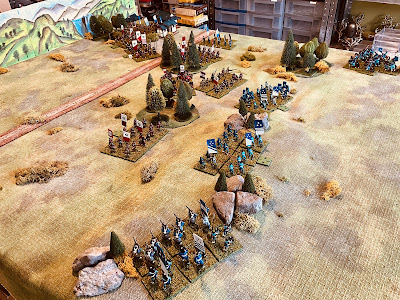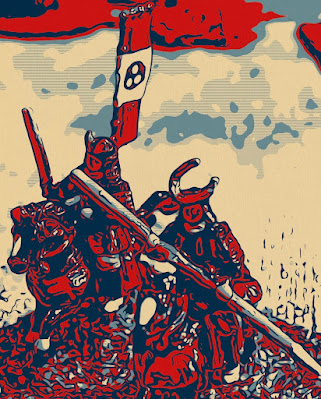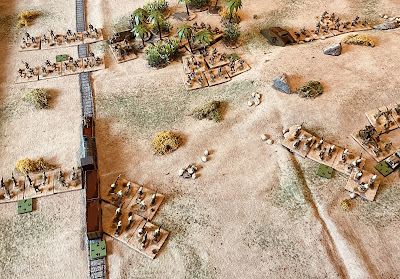This samurai game was played remotely with Jon of Palouse Wargaming Journal. The miniatures are a mix of old Miniature Figures S range and later range with a few Dixon miniatures thrown in.
 |
| A game set in the latter part of the Sengoku period (1467-1615). |
In setting up the game I gave Jon red army and myself Blue army which does not tie in with the blue and red on the map. These mistakes happen when you are focused on getting the camera setup and with a good angle for the remote player. The game used scenario 6 from One-Hour Wargaming - flank attack (1) with some additional terrain added to reflect Japanese terrain.
 |
| The briefing for the game |
 |
| Red Clan forces quickly progress down the road and push out screening units to protect their flank. |
 |
| Blue Clan forces are slow off the mark and are yet to attack the flank. |
Midway through the game…
My flank attack had finally started to engage Jon’s screening units and a cavalry unit had been sent back to support the town defenders who were under pressure.
 |
| The flank attack begins and Red Clan’s screening units come under attack. |
 |
| The defenders are under pressure. Only hanging on due to some timely rally tactic cards (see summary for details on the cards). |
End game…
Jon’s screening forces had done their job, allowing his main force to push a pathway through the defenders and begin exiting units off the north tabletop edge. My cavalry were too little and too late to make a difference and as each turn passed another unit slipped its way through.
A victory to Jon who met the objective of breaking through and existing 3 unit off the tabletop.
 |
| Blue Clan cavalry can be seen rushing to support the town defenders. |
 |
| Blue cavalry were held off allowing 3 Red Clan units to exit the north edge and win the game. |
Summary
Well played by Jon. The screening forces were sufficient to hold off my attack while his main force was able to grind through the defending line. I had placed a skirmish unit in the town defenders and with hindsight should have put a samurai unit there instead. Additionally, I should have used some of the tactical cards (see below) earlier on to advance the flank attack quickly and offset some of my problematic activations.
 |
| The flow of the game |
The rules used began as a variation of One-Hour Wargames using D3 dice for combat. Since then, activation has been added along with some battle tactic cards. As part of the game preparation players decide what battle tactics they are going to deploy. Having selected a strategy create a card deck made up of the 6 tactic cards. These cards remain hidden from the other player at all times and are only revealed during a player’s turn when they select one of their cards to play. A single tactics card can be played at the start of a player’s turn. They do not need to be played. Once used the cards are not refreshed.
 |
| Battle tactic card rules |
I hope to relight this scenario with Jon again soon. We may choose to switch sides.
 |
| Jon’s Red forces battle through to victory. |









































